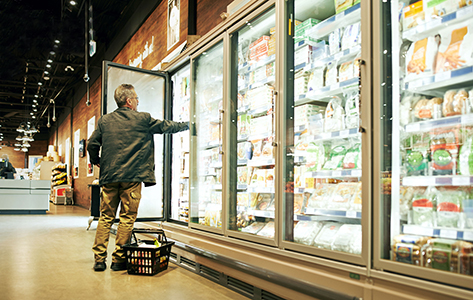According to the Food and Agriculture Organization of the United Nations, it is estimated that nearly one third of the food produced (about 1.3 billion tons) globally is not consumed. To help tackle this billion-dollar problem, an innovative solution is being deployed to detect one of the key factors driving food waste: Spoilage due to fluctuations in temperature.
To get to the dinner table, food must travel great lengths to preserve that farm fresh quality. Refrigerated shipping units and storage facilities are essential to reducing bacteria growth and by using an automated smart-refrigeration solution, a food-safe environment can be maintained throughout the journey with little supervision. Traditional food temperature monitoring is reliant on staff to periodically check temperature levels and make adjustments as necessary. This process is not scalable, meaning that with a larger facility or an increased number of food displays, it becomes increasingly labor intensive and inefficient. If employees are preoccupied, periodic check-ins may be delayed or missed entirely, leading to gaps where temperature fluctuations are not addressed, opening the door for increased bacteria growth and food waste.

To solve this issue, Internet of Things (IoT) sensors can be deployed in shipping vehicles, displays, refrigerators, and storerooms to provide accurate and consistent monitoring of temperature data. When a temperature fluctuation occurs, the sensors will send a signal to a low power, wide area network (LPWAN) gateway application. The information is then relayed to a network server, where it is routed to application servers or Cloud IoT services. The data is then processed and sent to the end user through a desktop or smartphone application. What’s more, in the event of a power outage, these long range, low power wireless enabled IoT devices are battery powered and consume minimal energy, allowing for consistent off-grid temperature tracking.
These connected devices can be found globally in a variety of use cases ranging from quick service restaurants to full service grocery stores, with an end goal of ensuring appropriate temperature levels for food. To support connectivity for these devices, an open network protocol is used to ensure the devices can be scalable and globally deployed. Two recent use cases where the long range, low power wireless devices and LoRaWAN protocol were used to actively monitor temperature fluctuations are Axino Solutions (Axino) and ComplianceMate.
Axino recently integrated LoRa devices and LoRaWAN protocol into its line of smart refrigeration solutions with the goal of combatting food waste. The solution combines sensor technology with automated data communication providing a substantial increase in measurement quantity and quality. Additionally, stores found a significant reduction in metering and operating costs after sensor deployment. This smart refrigeration solution has been globally deployed and is currently used by Switzerland’s largest supermarket chain, Migos. Axino’s sensors can be quickly installed, utilizing a magnet to attach to a refrigerator’s infrastructure. The sensors monitor temperature in real time, are accurate to one degree Celsius and can be pre-programmed to adjust refrigerator temperatures to ensure that food is stored in a safe environment. By having access to real time data and automatic temperature adjustment, supermarkets were able to eliminate human error, prolong shelf life and pass energy savings off to the customers.
The challenge for any wirelessly connected device is the presence of physical barriers that will block signals. Steel doors, concrete and insulation are some of the key considerations when developing a smart solution, especially in restaurants using large freezers. ComplianceMate partnered with Laird Connectivity and found that devices on a LoRaWAN-based network produces a more reliable signal than its Bluetooth counterpart. This IoT solution has been deployed in some of your favorite restaurant chains such as Shake Shack, Five Guys, Hard Rock Café, City Barbeque, and Hattie B’s and has already proved to be a huge asset. For instance, a sensor deployment saved $35,000 to $50,000 worth of inventory in a Hattie B’s location when downtown Nashville experienced a sudden power outage in 2018. The LoRa-based alert system immediately notified store management, allowing them to act quickly and prevent food spoilage.
Reducing global food spoilage is a monumental task. From farms to grocery stores and restaurants, technology must play a critical role, ensuring food remains at a safe temperature, preventing unnecessary spoilage. In the era of connectivity, businesses will turn to LoRa-based IoT deployments for its flexibility, durability and ability to provide real-time information to employees and decision makers to not only maintain strict industry standards in food safety, but to also pass savings on to their valued customers.








